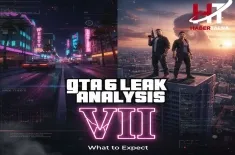Examining BG3 replayability and narrative complexity. How ethical choices, origin characters, and the Dungeons & Dragons ruleset create deep branching paths.
The monumental success of Baldur's Gate 3 (BG3) transcends typical gaming achievements; it represents a new gold standard for player agency and reactivity in the role-playing genre. The core of its viral popularity and critical acclaim is the profound depth of player choice and consequences. This isn't just a game where dialogue options slightly alter an outcome; this is a living, reactive world governed by a complex web of decisions that shape everything from minute character interactions to world-altering events. The result is unparalleled BG3 replayability and a dynamic experience that ensures no two playthroughs are ever truly alike.
The Foundation: Dungeons & Dragons Ruleset and Immersive Agency
Larian Studios built BG3 upon the robust framework of the Fifth Edition of the Dungeons & Dragons ruleset. This foundation is key to understanding the game's extraordinary depth of choice.
Dice Rolls and the Unpredictable Outcome
Unlike fixed-path RPGs, BG3 embraces the inherent unpredictability of the tabletop experience. Every significant interaction, from persuading a guard to examining a mysterious object, is resolved through a visible dice roll. This mechanism ensures that even seemingly safe or obvious dialogue options carry a risk of failure, forcing players to live with the immediate, often unexpected, consequences of a bad roll. This single mechanic is a massive driver of real-time engagement and hilarious viral clips where a critical 1 can derail an entire storyline.
Leveraging the Environment
Player choice extends far beyond dialogue trees. The game’s narrative complexity is often dictated by player creativity in manipulating the environment. Players are constantly encouraged to ask, "What would my character do?" rather than, "What does the game want me to do?"
- Verticality: Using spells like Feather Fall to bypass dangerous routes or Jump to access hidden areas immediately alters the traditional branching paths.
- Elemental Interactions: Using fire to ignite spilled oil or water to electrify a surface provides tactical combat choices that directly influence story outcomes (e.g., burning a hostile camp before they even see you).
Character and Narrative Complexity: The Branching Paths
The game's narrative depth is structured to react to the player's alignment, companions, and background, making it the central engine of BG3 replayability.
The Origin Characters and Their Choices
Players can choose from several predefined origin characters, each with a deeply personal, interwoven questline that provides an entirely unique perspective on the main plot. Playing as an Origin character is itself a massive choice, locking the player into a specialized narrative path.
- Astarion (The Vampire Spawn): His story is a quest for liberation. Player choices dictate whether he achieves true freedom or succumbs to a destructive lust for power, resulting in dramatically different endgame scenarios that affect the entire party.
- The Dark Urge (Durge): This origin provides the most extreme example of ethical choices. The player is constantly tormented by brutal, murderous urges. The choice to resist or succumb to these impulses leads to some of the most dramatic and shocking moments in the entire game, often ending in the death of key companion or NPC characters.
Reactive Branching Paths and World States
BG3's branching paths are not linear forks; they are multi-dimensional. A single, seemingly small choice—such as killing a goblin leader instead of negotiating with them—can drastically change the state of an entire region (e.g., the Druids' Grove), locking off dozens of quests, merchants, and future interactions. This level of reactivity is what fuels the viral nature of the game, as players constantly share their unique, often bizarre, world states.
Ethical Choices and the Viral Discussion Point
The "core viral discussion point" of BG3 revolves around moral ambiguity and the startling freedom to be genuinely evil or devastatingly heroic. The game consistently presents players with complex ethical choices where there is no clear "good" or "bad" option, only consequences.
The Scarcity of Pure Good or Evil
Unlike older RPGs with simple light/dark meters, BG3's choices are nuanced. For example, siding with the Goblins early on grants access to unique quests and gear while brutally sacrificing the safety of refugees. The reward for an "evil" choice is often immediate and material, tempting even morally upright players.
- The Goblin Camp Incident: The decision to either help the Druids or side with the Goblins is the earliest and most defining test of the player's alignment. The outcome irrevocably shapes the remainder of Act 1 and impacts the availability of key companions.
Companion Loyalty and Consequences
The companion system is heavily integrated into the player's moral compass. Companions are not static followers; they are morally complex individuals who will abandon the player if their core beliefs are violated too severely. For example, a heroic decision might cause the villainous companion Minthara to leave, while a brutal act might cause the noble Gale to desert the party. This mechanic reinforces the depth of consequences, as personal loss follows ethical deviation.
The Hilarious and Dramatic Results
The game’s engine is often praised for its ability to generate unexpected consequences. Viral discussion often centers on the dramatic results of player actions:
- A player attempting to save a character might fail the dice roll, accidentally killing them in a clumsy attempt.
- A player deciding to "Seduce" a fearsome villain might succeed, leading to an entirely unexpected narrative path, bypassing a massive battle.
These surprising outcomes are what drive the game’s longevity and make "What did you do?" the most common question in the BG3 community.




































